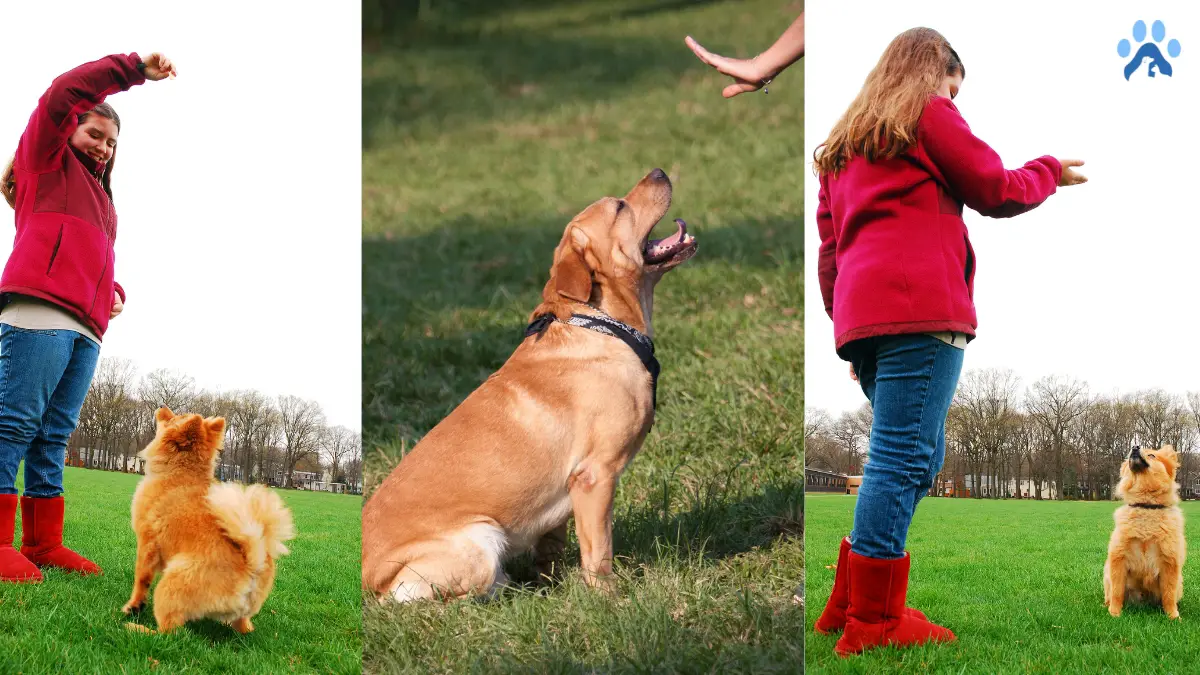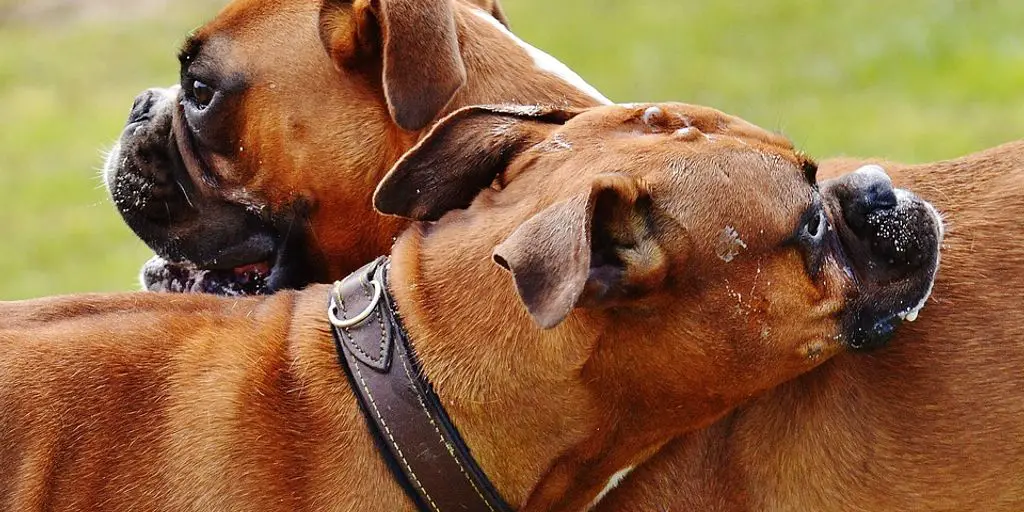Training a dog can be a challenging task, but it is also a rewarding experience. One effective method of training dogs is through the use of hand signals. Hand signals are a form of nonverbal communication that dogs can easily understand, and they can be used in conjunction with verbal commands to reinforce obedience.
Using hand signals to train dogs is not a new concept. In fact, it has been used for many years by professional dog trainers and owners alike. Hand signals are particularly useful for dogs that have hearing impairments or for those that are easily distracted by background noise. They are also useful for owners who want to communicate with their dogs in a quiet or crowded environment.
There are many different hand signals that can be used to train dogs, including signals for sit, stay, come, and heel. Each signal is unique and can be easily taught through repetition and positive reinforcement. By using hand signals in conjunction with verbal commands, dog owners can effectively communicate with their pets and reinforce good behavior.
Benefits of Training Dogs with Hand Signals
Training dogs with hand signals can have a multitude of benefits. Here are some of the most notable ones:
Improved Communication
Using hand signals in addition to verbal cues can help improve communication between dogs and their owners. Dogs are excellent at reading body language, and using hand signals can make it easier for them to understand what their owner wants them to do. This is especially helpful for deaf dogs, who won’t be able to hear verbal commands.
Distraction-Free Environment
Training with hand signals can also help create a distraction-free environment. When using verbal cues, dogs may get confused or distracted by other noises in the environment. However, hand signals are a visual cue that can help keep the dog’s attention focused on its owner.
Bonding
Training with hand signals can also help strengthen the bond between a dog and its owner. By spending time together and communicating through hand signals, the dog and owner can develop a deeper understanding of each other.
Positive Reinforcement
Using hand signals can also be an effective way to reinforce positive behavior. By using a hand signal in conjunction with a treat or praise, the dog learns to associate the hand signal with a positive outcome. This positive reinforcement can help speed up the training process and make it more enjoyable for both the dog and the owner.
Avoiding Common Mistakes
Using hand signals can also help avoid common mistakes that owners make when training their dogs. For example, owners may accidentally give their dogs a verbal cue when they don’t mean to, or they may use inconsistent body language. By using hand signals, owners can ensure that their communication is clear and consistent.
Research
Research has shown that dogs are highly attuned to visual cues, including hand signals. A study conducted by Megumi Fukuzawa and Marina Watanabe found that sight, sound, and smell can all cue dogs to a person’s presence. By using hand signals in training, owners can take advantage of this natural ability and make the training process more effective.
Overall, training dogs with hand signals can have numerous benefits. By improving communication, creating a distraction-free environment, strengthening the bond between dog and owner, using positive reinforcement, avoiding common mistakes, and taking advantage of dogs’ natural abilities, owners can make the training process more effective and enjoyable for both themselves and their furry friends.
Common Hand Signals for Basic Obedience Commands
When it comes to training dogs, hand signals are a useful tool to help them understand what you want them to do. Here are some common hand signals for basic obedience commands:
- Sit: Hold your hand up, palm facing out, and then lower it towards the ground. This is a universal signal for “sit.”
- Down: Point your hand towards the ground and move it towards your dog. This is a signal for “down.”
- Stand: Hold your hand out, palm facing down, and then move it upwards. This is a signal for “stand.”
- Come: Hold your hand out, palm facing towards you, and then move it towards your body. This is a signal for “come.”
- Stay: Hold your hand up, palm facing out, and then move it away from your body. This is a signal for “stay.”
- Heel: Hold your hand out, palm facing down, and then move it towards your hip. This is a signal for “heel.”
- Drop: Hold your hand out, palm facing towards the ground, and then move it downwards. This is a signal for “drop” or “leave it.”
- Wait: Hold your hand out, palm facing towards your dog, and then move it away from your dog. This is a signal for “wait.”
- Recall: Hold your hand out, palm facing towards your dog, and then move it towards your body. This is a signal for “come” or “recall.”
- Lay down: Point your hand towards the ground and move it towards your dog. This is a signal for “down” or “lay down.”
- Shake: Hold your hand out, palm facing towards your dog, and then move it up and down. This is a signal for “shake.”
- Roll over: Hold your hand out, palm facing towards your dog, and then move it in a circular motion. This is a signal for “rollover.”
- Spin: Hold your hand out, palm facing towards your dog, and then move it in a circular motion. This is a signal for “spin.”
- High five: Hold your hand up, palm facing towards your dog, and then move it towards your dog’s paw. This is a signal for a “high five“.
It’s important to remember that these hand signals are just one part of training your dog. It would be best if you also used verbal cues and positive reinforcement to help your dog learn. When teaching your dog hand signals, start with one command at a time and be consistent in your signals. With practice and patience, your dog will learn to respond to your hand signals.
Sources:
Teaching Hand Signals to Deaf Dogs
Training a deaf dog can be challenging, but it is not impossible. Deaf dogs rely on visual cues, so teaching them hand signals is essential. Here are some tips for teaching hand signals to deaf dogs:
Positive Reinforcement
Positive reinforcement is the most effective way to train a deaf dog. Use treats, toys, and lots of praise to reward your dog when they respond correctly to a hand signal. Avoid using punishment or negative reinforcement, as this can cause fear and anxiety in your dog.
Clicker Training
Clicker training can be an effective way to train a deaf dog. A clicker is a small device that makes a clicking sound when pressed. Click the clicker when your dog responds correctly to a hand signal, and then reward them with a treat or toy.
Common Hand Signals
There are several common hand signals that you can use to train your deaf dog. Here are some of the most important ones:
- Sit: Raise your hand from your side to be parallel with the ground.
- Stay: Hold your hand up with your palm facing your dog.
- Come: Pat your thigh with your hand.
- Down: Point your hand towards the ground.
- Heel: Hold your hand at your side with your palm facing your leg.
Training Process
When teaching hand signals to your deaf dog, start with one signal at a time. Use the same hand signal consistently, and reward your dog when they respond correctly. Once your dog has mastered one signal, move on to the next one.
Practice, Practice, Practice
Training a deaf dog takes time and patience. Practice your hand signals with your dog every day, and be consistent with your training. The more you practice, the faster your dog will learn.
In conclusion, teaching hand signals to a deaf dog requires patience, consistency, and positive reinforcement. By using common hand signals, clicker training, and a consistent training process, you can effectively train your deaf dog to respond to your commands.
Using Hand Signals to Improve Obedience Training
When it comes to obedience training, using hand signals can be an effective way to communicate with your dog. Hand signals can help your dog understand what you want them to do, even when they can’t hear you or are too far away to hear your voice. Here are some tips for using hand signals to improve obedience training:
Start with Basic Obedience Commands
Before you start using hand signals, make sure your dog is familiar with basic obedience commands like “sit,” “stay,” “come,” and “heel.” Once your dog has mastered these commands, you can start using hand signals to reinforce them.
Keep the Training Process Positive
Positive reinforcement is the most effective way to train your dog, and it’s especially important when you’re using hand signals. Make sure to reward your dog when they respond correctly to a hand signal. This will help them associate the hand signal with the desired behavior.
Use a Distraction-Free Environment
When you’re first teaching your dog to respond to hand signals, it’s important to do it in a distraction-free environment. This will help your dog focus on the hand signal and learn what it means. Once your dog has mastered the hand signal in a distraction-free environment, you can gradually start introducing distractions.
Teach Your Dog to “Watch Me”
Before you start using hand signals, teach your dog to “watch me.” This means getting your dog’s attention and having them focus on you. Once your dog knows how to “watch me,” it will be easier to get them to respond to hand signals.
Use Clear, Consistent Hand Signals
When using hand signals, it’s important to use clear, consistent signals. Use the same hand signal every time you give a command, and make sure your dog can see the signal clearly. You can use a combination of hand signals and verbal commands, but make sure the hand signal is the same every time.
In conclusion, using hand signals can be a great way to improve obedience training with your dog. By starting with basic obedience commands, keeping the training process positive, using a distraction-free environment, teaching your dog to “watch me,” and using clear, consistent hand signals, you can help your dog understand what you want them to do and reinforce good behavior.
Advanced Hand Signals for Tricks and Games
Training dogs with hand signals can be a fun and rewarding experience for both the dog and the owner. Once your dog has mastered the basic hand signals, you can move on to more advanced signals for tricks and games. Here are some advanced hand signals to teach your dog:
- Fetch Hand Signal: To teach your dog to fetch, use a throwing motion with your arm and point to the object you want your dog to fetch. Once your dog has retrieved the object, use a sweeping motion with your arm to signal your dog to bring the object back to you.
- Stand Hand Signal: To teach your dog to stand, use a flat hand signal and hold it out in front of your dog’s nose. Once your dog is standing, use a sweeping motion with your hand to signal your dog to remain standing.
- Look At Me Hand Signal: To teach your dog to look at you, use a finger-pointing motion and point to your eyes. Once your dog is looking at you, use a sweeping motion with your hand to signal your dog to remain focused on you.
- Trick Hand Signals: There are many different hand signals you can use to teach your dog tricks. For example, to teach your dog to roll over, use a circular motion with your hand to signal your dog to roll over. To prepare your dog to play dead, use a finger-gun motion and point at your dog to signal your dog to lay down and play dead.
It’s important to remember that dogs learn best through positive reinforcement. Use treats, praise, and affection to reward your dog for successfully completing a trick or game. Be patient and consistent in your training, and your dog will soon be performing advanced hand signals with ease.
For more advanced hand signals and tricks, there are many helpful resources available online. You can find charts and PDFs that outline different hand signals and how to teach them. With practice and patience, you and your dog can have a fun and rewarding training experience.
Conclusion
In conclusion, training dogs with hand signals is an effective way to communicate with your furry friend. It allows you to give commands even when your dog is at a distance or in a noisy environment. Hand signals also provide a visual cue that helps dogs understand what you want them to do.
When using hand signals, it is important to be consistent and clear. Use the same hand signals for each command and make sure they are easy to distinguish from each other. You can also pair hand signals with verbal cues to reinforce the command.
Remember that dogs are excellent at reading body language, so use your entire body to communicate with them. Use your eyes, facial expressions, and body posture to convey your message. For example, when giving the “sit” command, stand tall with your hand raised palm up. This will signal to your dog that you want them to sit down.
It is also important to be patient and positive when training your dog with hand signals. Dogs respond best to positive reinforcement, so reward them with treats, praise, and affection when they follow your commands. Avoid punishment or negative reinforcement, as this can damage your relationship with your dog and make training more difficult.
Overall, training dogs with hand signals is a fun and rewarding experience for both you and your furry friend. With patience, consistency, and positive reinforcement, you can teach your dog to respond to your hand signals and improve your communication with them.
Frequently Asked Questions
What are some common hand signals for dog training?
There are several hand signals that are commonly used in dog training. Some of the most common ones include:
- Sit: Hold your hand up, palm facing outwards, and move it downwards towards the ground.
- Stay: Hold your hand up, palm facing outwards, and move it away from your body.
- Come: Hold your hand out, palm facing up, and move it towards your body.
- Down: Hold your hand out, palm facing down, and move it downwards towards the ground.
- Heel: Hold your hand out, palm facing down, and move it towards your hip.
How do I teach my dog to respond to hand signals?
Teaching your dog to respond to hand signals requires patience, consistency, and positive reinforcement. Start by teaching your dog the verbal command for the behavior you want them to learn. Once they have mastered the verbal command, add the hand signal to the behavior. Use the hand signal every time you give the verbal command, and reward your dog with treats and praise when they respond correctly.
Are hand signals more effective than verbal commands?
Hand signals can be more effective than verbal commands in some situations. Dogs are visual animals and are often better at responding to visual cues than verbal ones. Additionally, hand signals can be useful for dogs that are hard of hearing or deaf. However, it is important to note that both verbal commands and hand signals are important tools in dog training and should be used together for maximum effectiveness.
What hand signal can I use to stop my dog from barking?
To stop your dog from barking, hold your hand up with your palm facing your dog and make a “stop” motion. This is similar to the hand signal for “stay,” but with a different meaning. When your dog stops barking, reward them with treats and praise.
What is the hand signal for ‘stay’ in dog training?
The hand signal for “stay” in dog training is to hold your hand up with your palm facing your dog and move it away from your body. This signal tells your dog to stay in place until you give them the release command.
What is the most difficult command to teach a dog?
The most difficult command to teach a dog can vary depending on the individual dog and its temperament. However, some commands that are commonly considered difficult to teach include:
- Off-leash recall: Teach your dog to come when called even when they are off-leash.
- Heel: Teach your dog to walk calmly by your side without pulling on the leash.
- Leave it: Teach your dog to ignore tempting objects or food on the ground.



